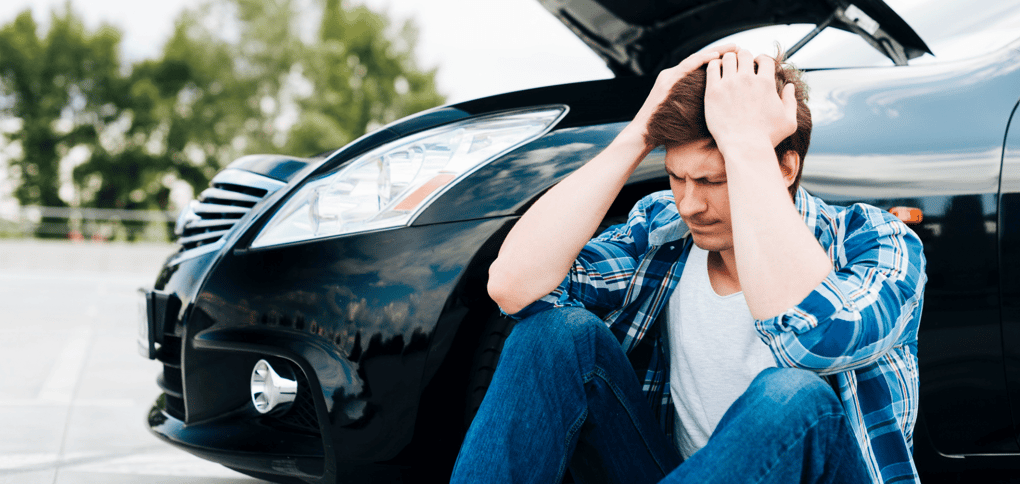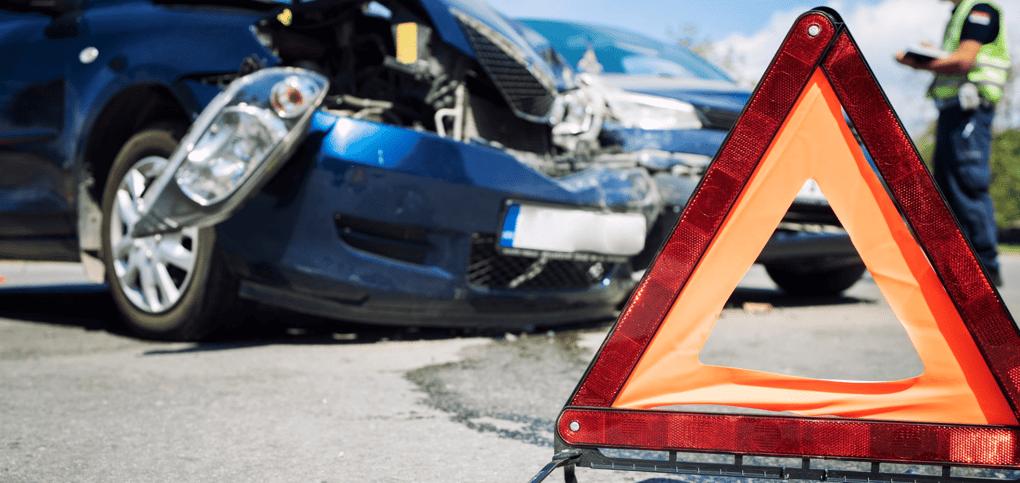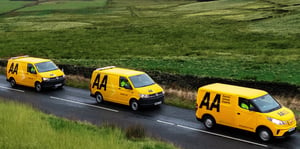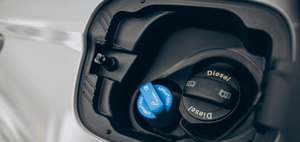Compare cheap breakdown cover
✔ Local, nationwide and European cover options
✔ Compare prices and choose the right policy for you
✔ Cover for cars, vans and motorbikes and scooters

Experiencing a breakdown can be a stressful situation for any driver. However, it’s crucial to stay calm and prioritise everyone’s safety if it happens. Whether you’re on a motorway, regular road, or at home, following our breakdown survival guide can help you navigate the situation.
- What should I do if my car breaks down on the motorway?
- What should I do if my car breaks down on a regular road?
- What happens after I call my breakdown provider?
- What happens if my car breaks down at home?
- What can I do if I don’t have breakdown cover?
- Find breakdown cover
- Frequently asked questions
What should I do if my car breaks down on the motorway?
Breaking down on a motorway can be a hazardous experience, so it’s crucial to know how to keep yourself and your passengers safe.
Here are some detailed steps to follow if your car breaks down on the motorway:
-
Be aware of your surroundings and be vigilant for any signs of trouble, such as smoke or strange noises, and get off the motorway as soon as you can. Take the next exit or pull into a service station. The longer you wait, the more dangerous it becomes.
-
If you can’t leave the motorway, pull over onto the hard shoulder and stop as far to the left as possible. Turn your wheels to the left, switch on your hazard warning lights, and if it’s dark or visibility is poor, turn on your fog lights too. Remember, never try to place a warning triangle on a motorway.
-
If you break down on a smart motorway where there’s no hard shoulder, try to stop in an emergency refuge area. These areas are marked with a blue sign with an orange SOS symbol. Smart motorways use CCTV to check for breakdowns and can close your lane once they become aware there’s a problem.
-
Get out of your car on the left and ask your passengers to do the same, so you don’t step into the path of passing traffic. If possible, wait behind a barrier and not behind your broken-down car. Keep a close eye on any children and leave any pets in the car with a window slightly open. If you have a disability that prevents you from getting out of the car, keep your seatbelt on and dial 999.
-
Don’t try to fix the problem yourself. Even if you think you know what’s wrong, don’t put yourself in danger by attempting even simple repairs. Your priority should be to stay safe.
-
Call your breakdown service via your mobile phone, or walk to an emergency phone on your side of the carriageway, keeping as far away from the traffic as possible. The phone is free and connects directly to an operator. Always face the traffic when you speak on the phone.
It’s essential to keep in mind that breaking down on the motorway can be a dangerous situation. Therefore, it’s crucial to follow these steps and prioritise your safety when you find yourself in such a situation.
Breakdown cover providers
Find the UK's leading breakdown cover providers below.
Compare cheap breakdown cover
What should I do if my car breaks down on a regular road?
Breaking down on a regular road can be inconvenient and potentially hazardous, so it’s crucial to know what to do to stay safe. Here are some detailed steps to follow if your car breaks down on a regular road:
-
Pull over to a safe place. Try to get out of the way of other vehicles so you’re not causing an obstruction, but watch out for ditches and soft verges. If you’re on a narrow road, pull over as far as you can to avoid causing an accident.
-
Turn on your hazard warning lights to warn other road users that you have a problem. If it’s dark or foggy, leave your sidelights on too. This will help make your vehicle more visible to other drivers.
-
Maximise your visibility. Wear light-coloured or fluorescent clothing in daylight, and reflective clothing at night or in poor visibility. The more visible you are, the safer it is for everyone. It’s a good idea to keep a fluorescent vest in your car, along with the rest of your breakdown kit, just in case.
-
Put your red warning triangle on the road if it’s safe to do so. The triangle should be placed at least 45 meters (about 60 steps) behind your broken-down vehicle, on the same side of the road. Walking near high-speed traffic is dangerous, so skip this step if there are a lot of passing vehicles.
-
Never stand between your vehicle and oncoming traffic or anywhere that will prevent other road users from seeing your car’s lights. Always stand on the opposite side of the road and behind a barrier if possible.
-
Call your breakdown service to come and help you. If you’re not sure of your location, look out for road signs or notable landmarks. Some providers have an app you can use to pinpoint your location. This will also keep you updated on your mechanic’s progress while you wait.
-
Call the police on 101 (the non-emergency number) if your car is blocking the road. They may need to divert traffic or make the area safe.
-
Stay in your car until help arrives. As long as your vehicle is parked safely, it’s better to wait in the car. If you’re not familiar with the area you’re in, you might feel safer locking the doors.
In conclusion, it’s essential to keep in mind that breaking down on a regular road can be a potentially hazardous situation. Therefore, it’s crucial to follow these steps and prioritise your safety when you find yourself in such a situation.
How much can you save on European breakdown cover?
What happens after I call my breakdown provider?
When you call your breakdown provider, there are some steps that you can expect to happen. Here’s what happens after you call your breakdown provider:
-
Once you’ve reported your problem, your breakdown provider will arrange for a mechanic to come out to you. Most breakdown services aim to get to you within the hour, but response times can be as quick as 30-45 minutes.
-
If the mechanic can fix your vehicle at the roadside, you’re free to go on your way. But if they can’t, what happens next will depend on your level of cover and the type of breakdown cover you have.
-
If you have roadside assistance, you’ll be recovered and taken to a nearby garage where your vehicle can be repaired. This type of cover typically only covers you for breakdowns that occur away from home.
-
If you have national recovery, and your vehicle can’t be fixed that day, you can be recovered and taken to any location in the UK. Alternatively, onward journey cover could involve an overnight hotel stay or use of a courtesy car while your vehicle is being repaired so you can get to where you need to be. This type of cover is more comprehensive and will cover you if your vehicle breaks down at home or anywhere else in the UK.
-
It’s important to keep in mind that the level of cover you have will depend on the breakdown policy you choose. It also makes a difference whether you have cover for any car you’re travelling in or only cover for one car. So, be careful when choosing a breakdown policy to make sure you get the protection you need.
In conclusion, knowing what to expect after you call your breakdown provider can help you make an informed decision when choosing the best breakdown policy for you.
Learn how you can be prepared in case your vehicle breaks down with our breakdown checklist.
How much can you save on classic car breakdown cover?

What happens if my car breaks down at home?
Breaking down at home can be frustrating, but if you have home start cover, you have options for getting back on the road.
Here’s what you need to know if your car breaks down at home:
-
If you develop a problem before you even set off, like a flat battery, or you’re very close to home when you break down, you can call for assistance if you have home start cover. A mechanic can be sent out straight away to your home to assess and fix the issue.
-
If your car can’t be repaired on the spot, it can be recovered and taken to a garage to get it fixed. Depending on your level of cover, this may be a nearby garage or any garage of your choosing.
-
It’s important to note that the level of cover and the type of assistance you receive will depend on the breakdown policy you choose. Some policies may offer more comprehensive home start cover, while others may offer limited assistance. Be sure to review your policy details to understand what’s covered and what’s not.
-
If your car is not roadworthy and cannot be driven, some breakdown providers may offer a courtesy car while your vehicle is being repaired. Others may offer alternative transportation or overnight accommodation, depending on the level of cover you have.
In conclusion, if your car breaks down at home, you have options for getting back on the road. Whether it’s a mechanic sent straight to your door or a recovery service to take your car to a garage, the level of assistance will depend on the breakdown policy you have.
What can I do if I don’t have breakdown cover?
Breaking down without breakdown cover can be a stressful experience, but you still have options to get back on the road. Here are three things you can do if you don’t have breakdown cover:
-
Get instant breakdown cover. You can phone a breakdown service to get help even if you’re not a member. Some providers offer one-off instant cover which may be charged at a higher rate than their regular membership. It’s important to note that this can be an expensive option, so it’s worth shopping around and comparing prices from different providers before making a decision.
-
Call a local garage to see if someone can come out to pick up your vehicle. Some garages offer a breakdown recovery service, which may be less expensive than calling a breakdown provider. However, be aware that there will likely be a callout fee and you’ll be charged for each mile you’re towed. Additionally, this is only an option during garage opening hours.
-
Contact Highways England using the emergency phones if you break down on the motorway. A recovery vehicle will be sent to tow you to a local garage for a fee of at least £150. If your vehicle breaks down in roadworks, it can be removed to a safe place for free in certain circumstances. Similarly, if you’re driving in Scotland, Wales or Northern Ireland, use the emergency phones to call for help.
It’s important to remember that not having breakdown cover can be expensive and inconvenient, especially if you regularly travel long distances or have an older car that’s more likely to break down. As such, it’s recommended to consider purchasing breakdown cover to provide peace of mind and protection in case of a breakdown.
Compare cheap breakdown cover
Find breakdown cover
Fortunately, many breakdown situations can be resolved with roadside repair or recovery. Having breakdown cover in place can give you peace of mind knowing who will be coming to help and what’s covered by your policy.
There are many providers to choose from, so it’s important to compare different options to find a great-value deal. Consider factors such as the level of cover offered, response times, and additional benefits like onward travel or home start cover.
By comparing breakdown cover options, you can find a policy that meets your needs and budget, and ensure that you’re protected in case of a breakdown.
Frequently asked questions
You should not sit in a broken-down car during a breakdown. It is best to try and get your car off the road as it could still be a hazard and you could be at risk of a collision.
If your car breaks down on the highway, it is recommended that you stay with the vehicle.
However, if you need to exit the car, do so on the side facing away from the road and stay a few paces away from the vehicle for added safety. It is important to call for help while remaining with the car.
On average, a conventional car can last up to 200,000 miles, although some well-maintained models can reach 300,000 miles or more.
The average age of a passenger car in the United States is around 12 years. Opting for a well-built make and model can help increase your car’s longevity.
Unusual noises coming from your car could be a sign that it’s about to break down.
If you hear grinding, hissing, or squealing sounds, or any other noise that is not normal, it’s important to get it checked by a mechanic. Ignoring these noises could lead to a sudden and unexpected breakdown.
A common reason for a random car breakdown is a flat or faulty battery.
If your car struggles to turn the engine over or takes longer than usual to start, it may be a sign of a worn-out or flat battery.










